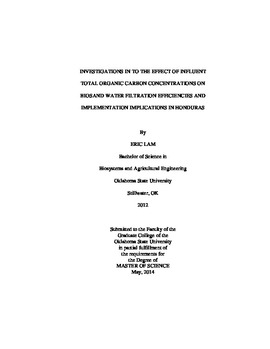| dc.contributor.advisor | Wilber, Gregory | |
| dc.contributor.author | Lam, Eric | |
| dc.date.accessioned | 2015-06-17T20:06:41Z | |
| dc.date.available | 2015-06-17T20:06:41Z | |
| dc.date.issued | 2014-05-01 | |
| dc.identifier.uri | https://hdl.handle.net/11244/14954 | |
| dc.description.abstract | This document is a compilation of three papers, made for publication, detailing the findings from research conducted in a laboratory and in Honduras regarding the implementation and monitoring of the household, point-of-use, water treatment technology known as intermittent slow sand filters (ISSF), also known as biosand filters (BSF). While laboratory results have shown biosand filters can provide a high degree of biological removal from contaminated water, field results can vary greatly. Three trials using six 1/30th scale volume filters and a full scale filter were conducted, varying total organic carbon (TOC) and biodegradable dissolved organic carbon (BDOC). Fecal coliform (FC) removals, nitrate concentrations, and sulfate concentrations were analyzed to better understand how aerobic and anaerobic conditions affect filtration efficiency. Higher organic loadings had a higher oxygen demand on the "schmutzdecke" layer of the sand filters. Filters with a standing head DO of 3mg/L or less had signs of the filters turning anaerobic, conditions unconducive to pathogen removal. Filters with TOC loadings higher than 20 mg/L and BDOC loadings higher than 10 mg/L can turn anaerobic, generating more anaerobic organisms than are removed. By working with communities around the Campana region of Honduras, wooden molds were developed for the construction BSFs. Entirely sourced from in-country materials and labor, a local production facility and foreman was established to provide the filters and clean water information to the surrounding communities. Rotary style sieves were developed to process the filtration medium, reducing the labor required per filter. Under the moniker of AguaSeis filters, the filters were sold for $25.00 USD with a material cost of $7.50 USD per filter. The concerted effort of having a sustained, local BSF production and adoption was carried out between March 2011 and January 2014. During that time, 46 filters were made in-country with 72% still in operation. An averaged removal rate of total coliforms, sampled from 27 filters, was found to be 91%. | |
| dc.format | application/pdf | |
| dc.language | en_US | |
| dc.publisher | Oklahoma State University | |
| dc.rights | Copyright is held by the author who has granted the Oklahoma State University Library the non-exclusive right to share this material in its institutional repository. Contact Digital Library Services at lib-dls@okstate.edu or 405-744-9161 for the permission policy on the use, reproduction or distribution of this material. | |
| dc.title | Investigations in to the Effect of Influent Total Organic Carbon Concentrations on Biosand Water Filtration Efficiencies and Implementation Implications in Honduras | |
| dc.type | text | |
| dc.contributor.committeeMember | Sanders, Dee Ann | |
| dc.contributor.committeeMember | Weckler, Paul | |
| osu.filename | Lam_okstate_0664M_13351.pdf | |
| osu.accesstype | Open Access | |
| dc.description.department | Civil & Environmental Engineering | |
| dc.type.genre | Thesis | |
| dc.subject.keywords | biolayer | |
| dc.subject.keywords | biosand | |
| dc.subject.keywords | developing countries | |
| dc.subject.keywords | honduras | |
| dc.subject.keywords | intermittent | |
| dc.subject.keywords | slow sand filter | |
